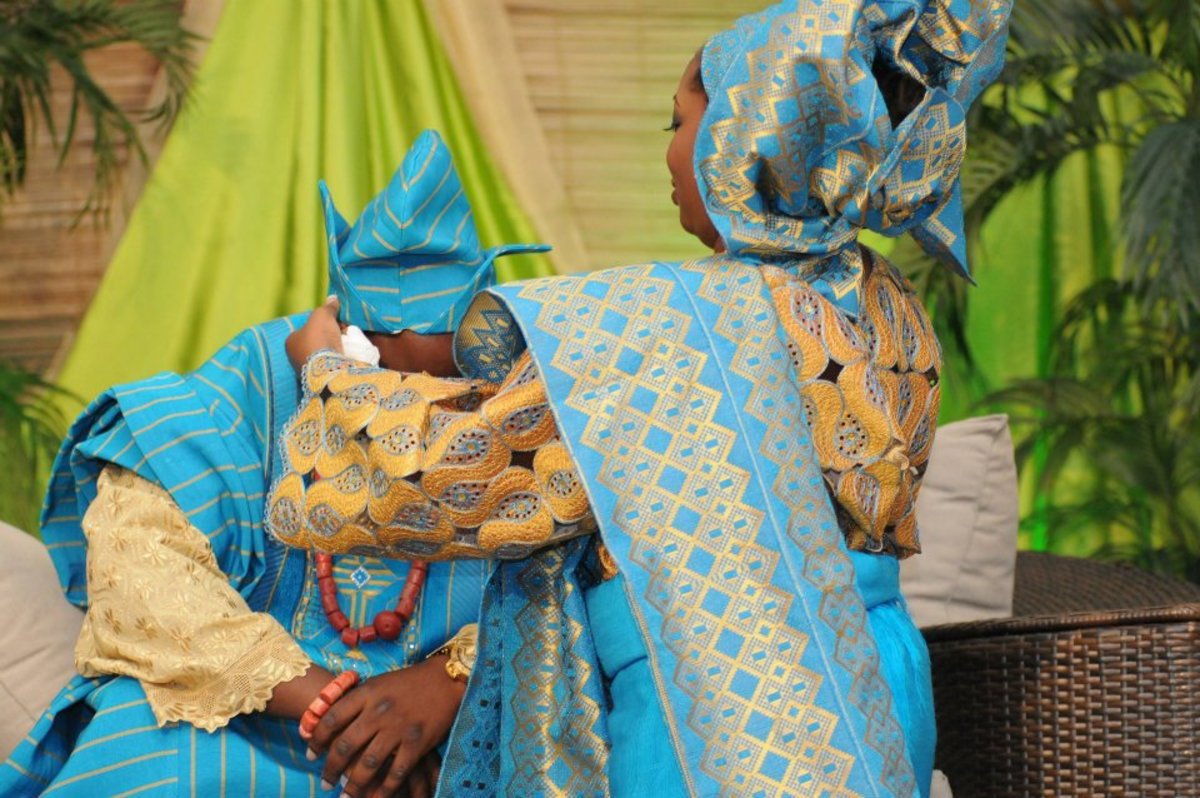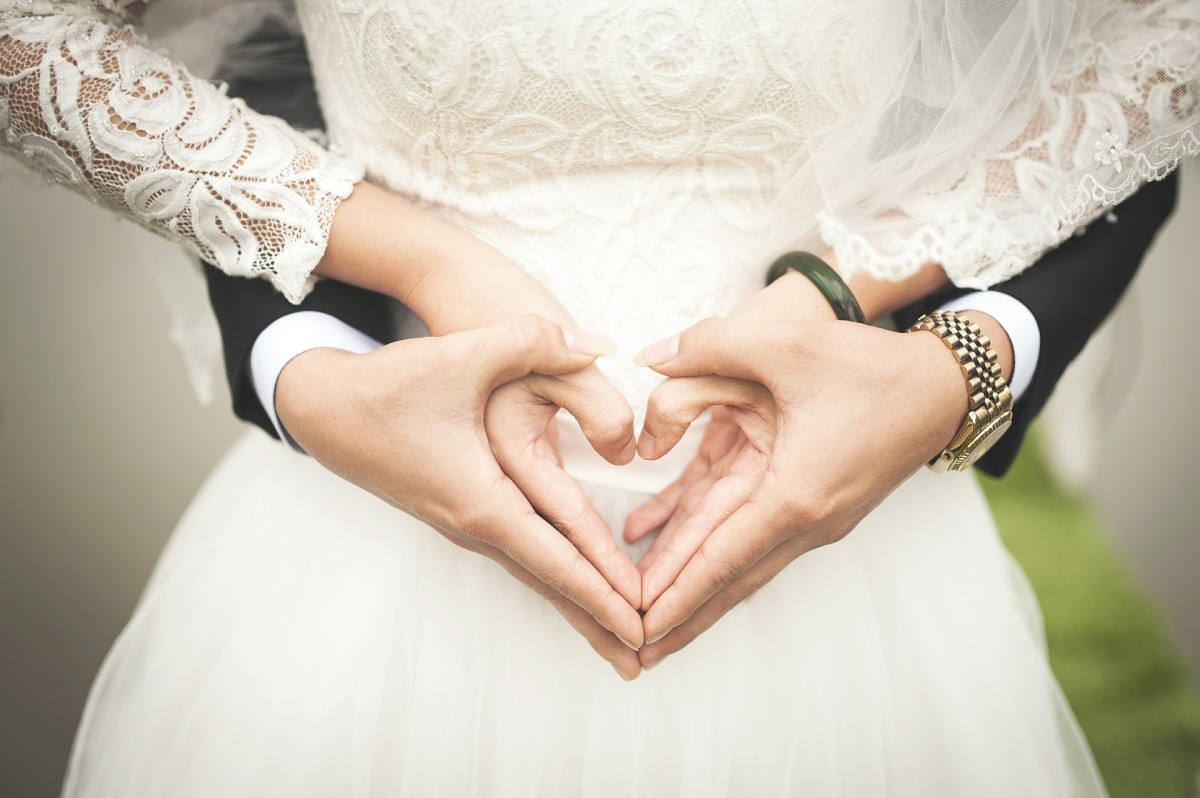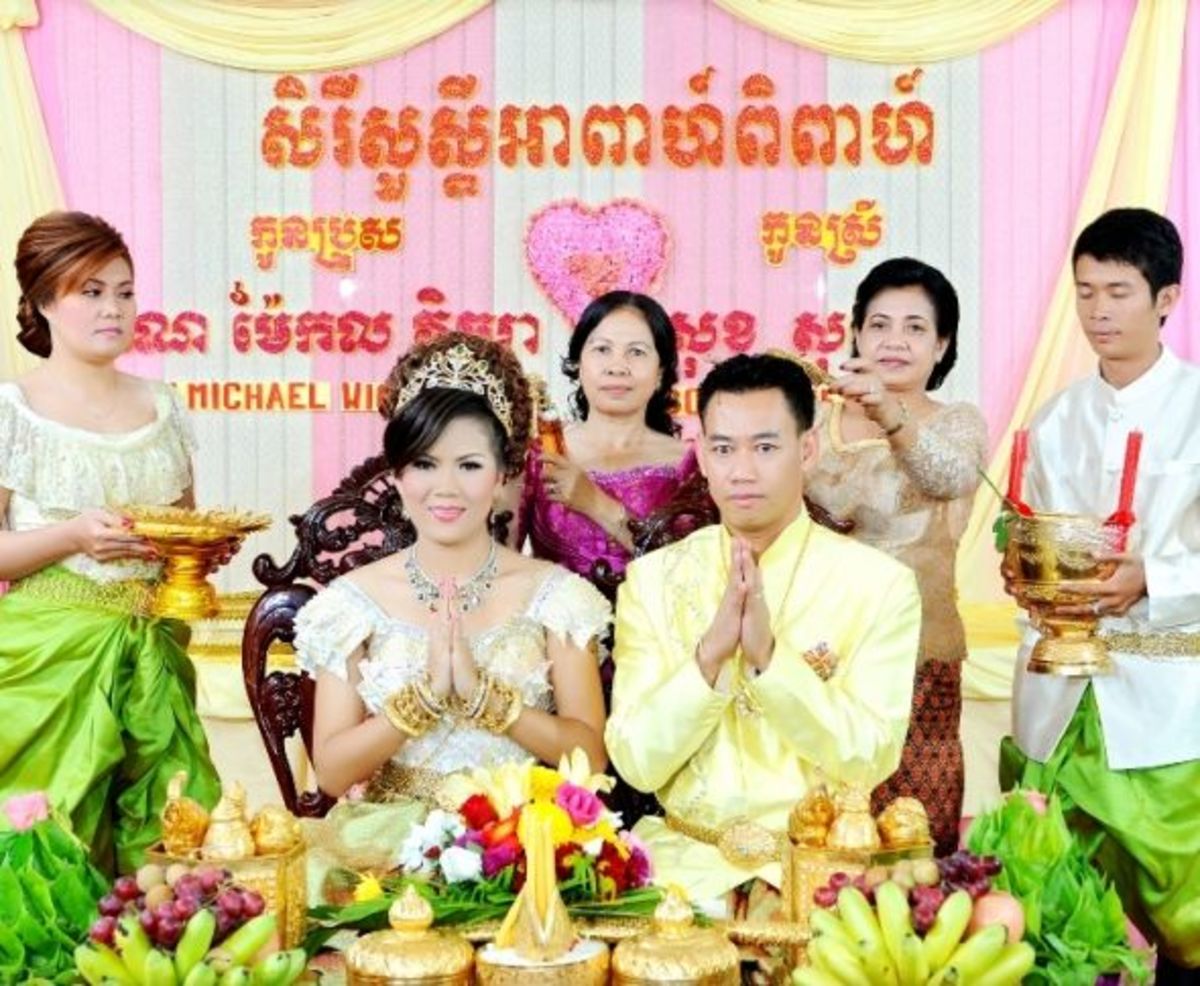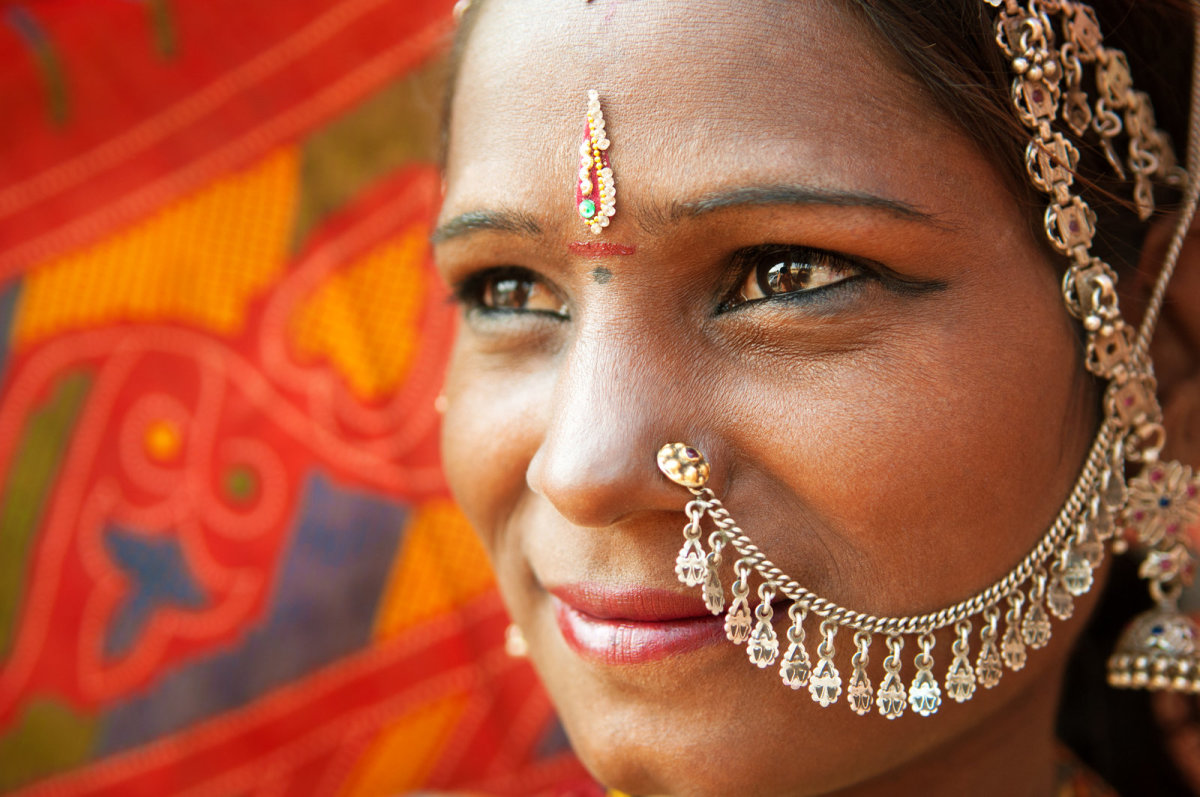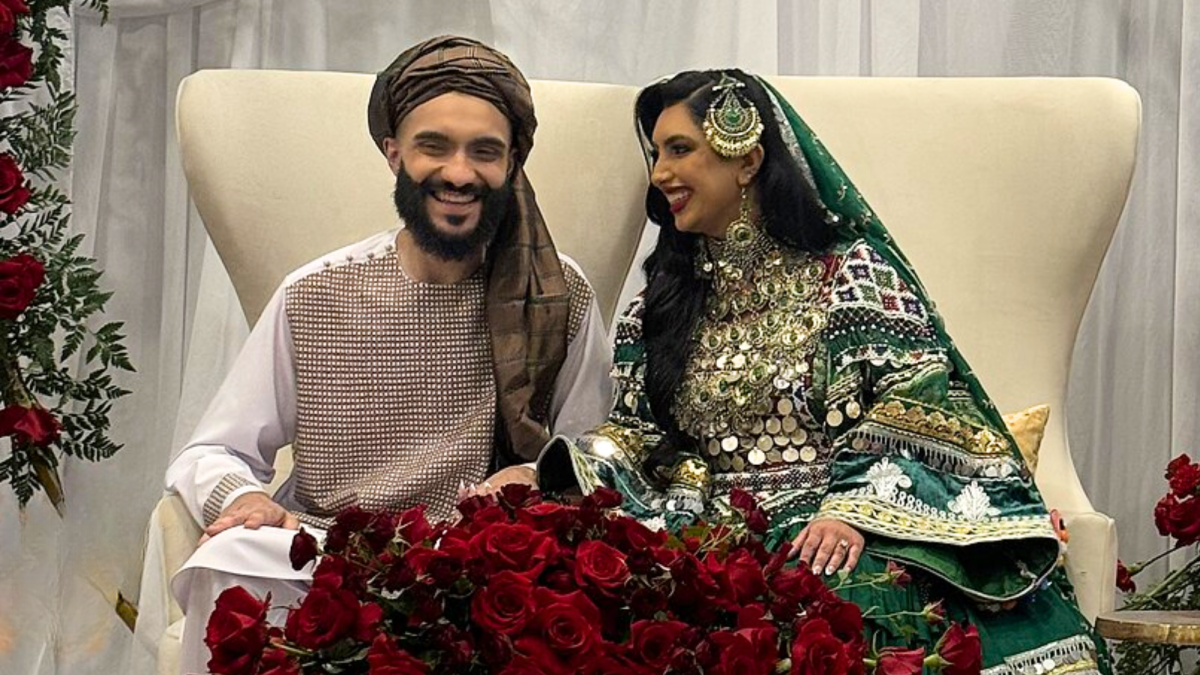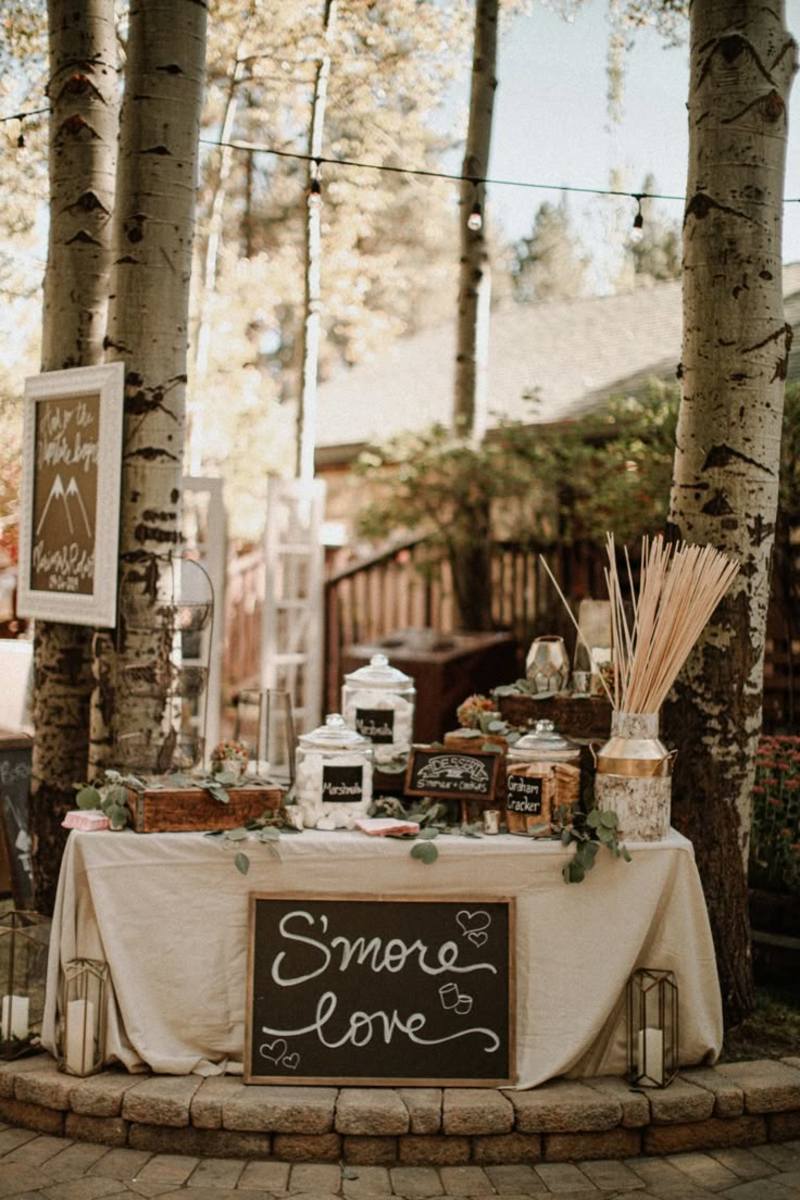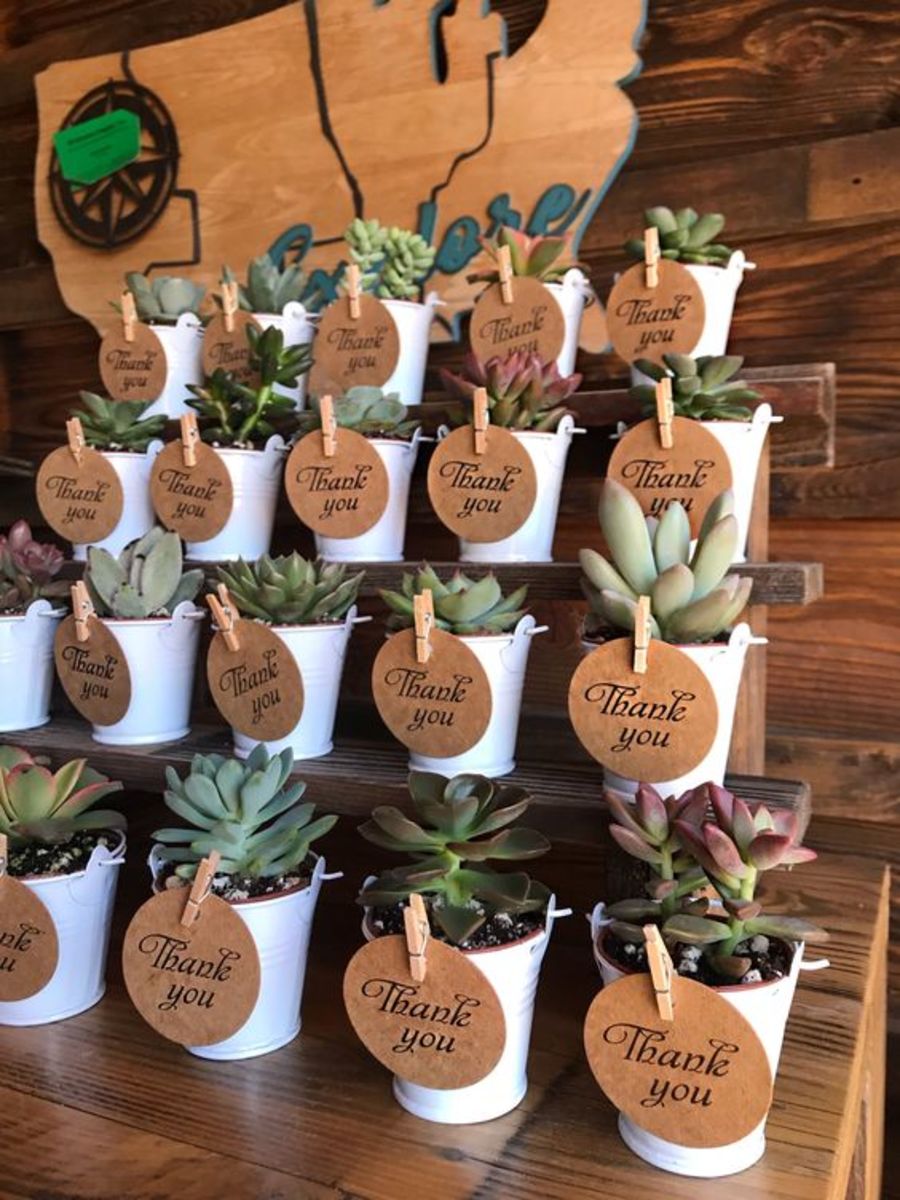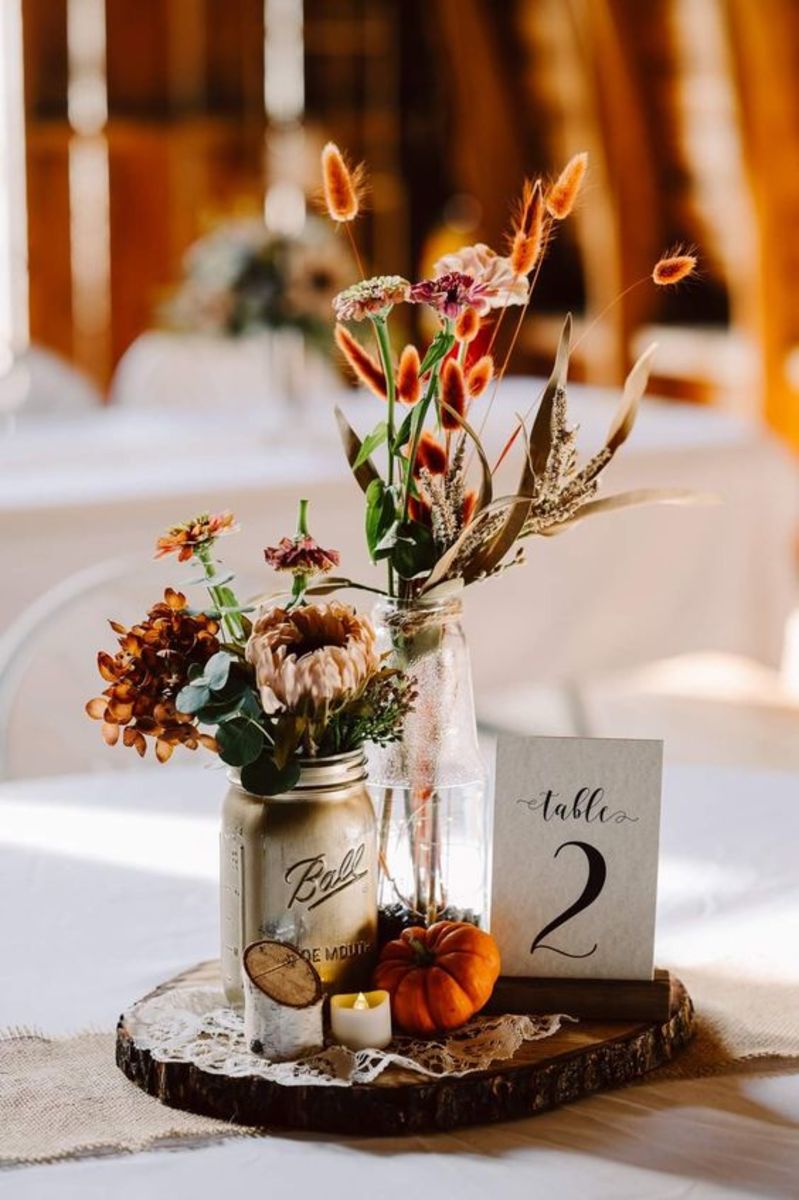A Traditional Scottish Wedding

Scottish Wedding Law
In Scotland you can exchange your wedding vows practically anywhere you desire too. You can say 'I DO' to the love of your life, by a 'scottish loch', in a romantic glen, on the shore of a snady beaach or even at the top of Arthur's seat! The minister, priest, celebrant or clergyman who is conducting your wedding ceremony carries a licence that means you can choose your wedding venue, no matter how romantic or wild! If you would prefer to have your wedding inside, Scotland has plenty of places on offer, from anicent castles to your local village hall, the possibilities are endless!
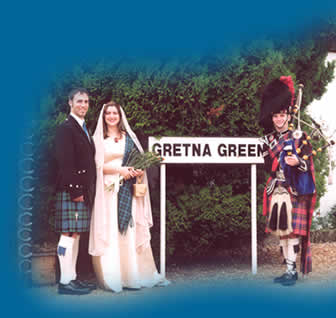
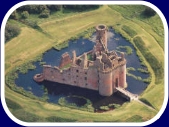

Where You Can Get Married In Scotland?
Remember there is a 14-day waiting period once you give your notice of marriage to your parish; these are called 'The Marriage Banns'.
If you are having a Register Office (Civil Ceremony) wedding, it will usually take place during working hours, however, due to recent changes in Scottish law, your wedding can take place anywhere that is agreeable for all involved.
If you are wanting to have a Religious Ceremony it can be held anytime or any place that a licensed celebrant is agreeable to. As long as the licensed celebrant whom you have asked to conduct your forthcoming marriage is willing to conduct your wedding ceremony, all of Soctland is a possible wedding venus.
What Happens If You Don't Live In Scotland But Want To Marry In Scotland?
Currently in Scotland there is no prior residency requirements. it is, however, necessary that you observe th eminimum 15 days and your marriage schedule has to be collected in person prior to your religious ceremony.
If one of the partner's lives in Scotland and the other lives in England or Wales, there is no need for the person living across the border, to travel to Scotland prior to the wedding. It is possible for your forthcoming marriage to be given to English or Welsh Superintendent Registrar of the District you live in. Scotland recognises marriage notices that are posted in England and Wales.
Traditions In Scotland Prior to your Wedding Ceremony
Prior to a Scottish bride getting married, the mother-of-the-bride traditionally has an 'open house' for the traditional 'show of presents'. Those people who have given the couple a wedding gift usually get an invitation through the post to attend this event. All of the wedding gifts that are received are unwrapped and put on display for the guests to admire. After the show of presents, the bride is normally dressed up and her friends will escort her through the town/village singing and banging pots and pans, heralding the bride's forthcoming wedding day.
Prior to the wedding, the groom-to-be is normally taken out on a 'stag night'. The idea of a 'stag night' is meant to celebrate the last night of 'freedom', whilst also assuring his friends that just because he is getting married it does not mean that he is shutting them out of his life. Like the bride, the groom is also dressed up and taken around his town/village by his friend and workmates. the groom is normally subjected to a lot of harmless practical joking. As the night starts to wind down some grooms-to-be can be parted with their clothes and might be covered in feathers, soot or treacle and left tied to a tree or post for a few hours or overnight. In some rural areas the groom-to-be's friends and workmates night hire an open lorry in order to parade him through their town/village with a lot of celebration and noise.

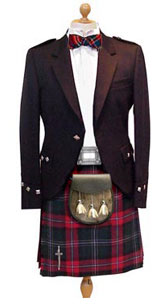
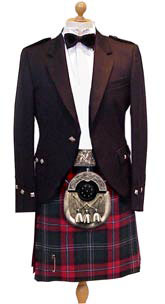
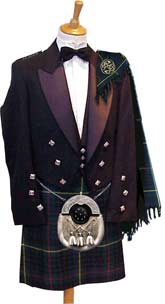
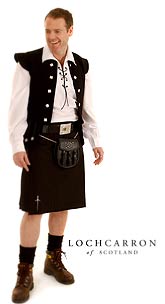
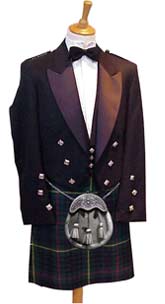
Traditional Scottish Dress
Any Scottish bride traditionsally wears either a cream or white Wedding Dress/Gown/Outfit. The Bride's Father and the Groom's Party usually go to the wedding resplendished in Full Highland Dress in his Clan's traditional tartan. The Bride may also carry a horseshoe on her arm for GOOD LUCK, or a page boy may give her a horseshoe as she arrives for the Wedding Ceremony.
Traditional outfits can bring a touch of splendour to any wedding Bonie Prince Charles Jacket and Waistcoat, kilt, tartant plaids to match, white hose, gillie brogues, kilt pin, sglan dubh, black belt with buckle, formal sporan white chain strap, wing collar, shirt, balck or cloloured bow tie, a piece of lucky white heather on their lapels. The men can also have the option of wearing a fly plaid, which is usually anchored under the paulette on the shoulder of the jacket and is secured in place by a large plaid brooch.
All the bridesmaids wear whatever the bride chooses them to wear, althoughthe design the bride choses normally matches her own and may have a little tartan accessory if the bride wishes. Prior to 1499 women woud wear their best outfit to get married; after Anne of Brittant wore white in this year, it became tradition as some people interpreted white as being a sign of chastity.
Bride and Bridesmaids bouquets can include bows and tartant riboons.
Old Scottish Wedding Traditions
Although Scottish Wedding customs have changed over the years. Some parts of your wedding will be steeped in traditio; you will be glad to hear that some customs have died out over the decades!
In Barra, it use to be traditional for water to be sprinkled on the marriage bed and then blessed.
In Mull, traditionally any newlyweds would have to spent their first night as a married couple in a barn.
In Lewis, the newlywed couple would have to spent the first week of their married life living with the bride's parents before moving into their own homw.
Many hundreds of years ago Celtic practices were part of wedding ceremonies and had roots in pagan rituals. 'Tying the knot' comes from the bride and groom originally ripping their wedding plaids (clan tartans) off and tying the two strips together as a symbol of the unity of the two families.
Gaelic tradition sys it is unlucky for you to get married in May or during a waning moon.
Tradition says sew a lock of hair into the hem of your wedding dress will bring you luck, or even a drop of blood fall onto one of the dress/gown/outfit inner seams. If the brides dress is complicated she must not try it on prior to her wedding day. If you are having your dress made by a dressmaker to facilitate the tradition of putting a lock of hair into the hem a small section of the hem will be left unsewn till the last minute.
When the bride leaves her home for the last time as a single woman, she should leave the house eith her right foot first for luck.
Penny Bridal or Silver Bridal - This was also known as a 'penny wedding' and was renowed for drinking, dancing, feasting and fighting and everyone seemed to enjoy it, apart from the clergy - who disapproved of the raucous behaviour. The newlyweds were givengifts that would help towards the cost of the wedding feast, these celebrations would start on the eve of the wedding with singing, toasts and the 'feet washing ceremony'.
Feet Washing - A tub of water would be placed in the best room and the bride would place her feet in ti, all of her female friends would then gather round the tub and take turns in washing her feet. Prior to this, the wedding ring from a happily married woman would have been placed into the tub. Traditionhas it that whoever found the ring would be the next person to get married.
Whilst this was happening to the bride-to-be, all the men would be at the door entrance trying to watch and making jokes. The groom-to-be would then be seized by all of the women and made t sit at the tub. The groom-to-be would then be subjected to his legs being roughly daubed with ashes, cinder and soot, which was a painful procedure.
The Wedding Procession - The day of the wedding the bridal party make their way to the church, with flower petals being thrown in front of the bride. However, if the bride meets a funeral or a pig on the way to the church, she should return home nd set off to the church again, as meeting a funeral or a pig on your way to be married is considered bad luck.
The first person that they met after they was married was called the first foot, the bride would give the person a coin and a drink of whisky. The person would then have to accompany the bridal party for approximately one mile before they would be allowed to go back to their own business.
The Highland Custom of Creeling the Bridegroom - The bridegroom would have a 'creel' or large basket filled with stomes tied to his back. If the bride did not agree to giving her groom a kiss, the groom's friends would not allow him to escape the 'creeling' and he would have to do a curcuit of the town. The only way the groom would escape the 'creeling' was for his bride to agree to kiss him.
Handfasting - Handfasting was observed during the 18th century. A couple would co-habit for a year and one day, and they they would have to decide whether they wanted to make a lifetime commitment to each other or not. During this era in history it was considered more important for the bride to have experience and be fertile than be a virgin
Wedding Traditions in Various Parts of Scotland
A SIXPENCE in the Bride's Shoe Traition can be found in Aberdeen& Grampian and Augus & Dundee. The Sixpence is placed in the Bride's shoe as according to folklore it is supposed to bring her good luck. However, the the Scottish Borders if there is a sprig of Heather hidden within the Bride's Bouquet she will have good luck.
A wedding scamble can be found in Aberdeen & Grampian, Augus & Dundee, Ayrshire & Arran, Dumfries & Gallwoway and Fife. As the bride steps into her wedding car; her father should throw a handful of coins onto the ground for the children to gather. This is called a 'scamble' and it is again according to folklore suppose to bring financial luck. In Ayrshire it is better know as a 'Warsel'.
In Aberdeen & Grampian amd all Fishing Communities in the North East of Scotland, the traditional dance is the 'Lang Reel'. This dance sees all the villagers and Wedding Party start dancing at the harbour and continuing through the willage, whilst people drop out when they pass their home. This dance continues until the only couple who are left are the Bride and Groom whom will than have a last dance.
If you are the Bridegroom in Aberdeen & Grampian, Angus & Dundee, Fife, Orkney and the Outer Hebrides, the 'blackenings' tradition is still performed with great gusto. If you are the Groom-to-be you best be aware, your friends will capture you and strip you to the waist before they 'blacken' you. Your friends will use such substances as feathers, flour, soot and treacle! The Groom-to-be will then be paraded through the village, whilst his friends make as much moise as they can, they do this to make the experience as embarrassing as possible to the Groom-to-be. Brides-to-be dont be laughing, as in some parts of Scotland, this can happen to you!
In Aberdeen & Grampian, Orkney (both band rather than pipes), Outer Herbrides and Shetland, the spectacular procedure of the traditional Grand March at the Wedding Reception is often the first dance to take place at the wedding. It normally starts with the Bride and Groom marching to the bagpipes or a live band. As they march, the maid-of-honour (or Chief Bridesmaid) and the best man join in, then both sets of parents join in and finally all willing guests.
In Aberdeen & Grampian if you are being a Best Man you should buy the couple a clock. if you are Maid of honour your wedding gift to the couple should be a tea set.
In Augus & Dundee and Fife the feet washing tradition still happens and according to folklore it is suppose to guarantee good fortune for the marriage. Traditionally the bride will sit on a stool, whilst an older, married woman will wash and dry her feet. The Bridegroom's in Fife don't escape, some heartened Bridegroom's will go through with this tradition; although they have to endure sitting on a stool, feet in a tub of water, they also have their legs smeared with ash, gease and soot.
In the Scottish Borders, the newlywed couple will usually be 'creeled' as they leave the church. Two people will stand at either side of the entrance whilst holding a fishing basked that is tied with a ribbon across the door. The newlywed couple then cut the ties and the baskets fall onto the ground. This tradition it is hoped will bring the couple health and prosperity.
If you are attending an Orcadian Wedding in Orkney they night pass round a wedding Cog from which ale will be consumed. the cog was undoubtly the esstenial ingredient that made up any old Island Wedding, this is still a prominent feature in the 21st century. The exact mixture that goes into the Wedding Cog varies at each wedding, which is due to each family having their own variations, the basic ingrediants of this potent alcoholic mixture is normally brandy, gin, hot ale and whisky all mixed with pepper and sugar. The bride normally drinks out the Cog before passing it around the hall, constantly being replenished so that no guest goes dry!
In the Shetland Islands a 'second night' is normally held the night after the wedding - where people will enjoy another night of dancing and drinking!
Something OLD, NEW BORROWED and BLUE
All over the world the custom for any bride is 'Something old, something new, something borrowed, something blue' - of course, the 'something new' for the bride is usually her wedding dress/outfit/gown. At some weddings the 'Something new' can also become the 'something old or borrowed' for the next generation's wedding. Some brides traditionally wear a blue garter, which symbolizes love; this normally plays a part at the wedding reception.
SOMETHING OLD - This is usually a gift from the Mother-of-the-Bride to her daughter to start off married life, that symbolizes the passing on a bit of wisdom from mother to daughter.
SOMETHING NEW - Normally a gift symbolizing a new start to married life.
SOMETHING BORROWED - The notion here is that the newlyweds borrow something from a happily married couple in the hope that a little bit of their martial bliss will rub off on them.
SOMETHING BLUE - There is two likely souces for this tradition. The first is thought to be Romen women used this colour to border their robes, as blue was a sign of fidelity, love and modesty. The second is the colour blue is usually associated with Mary, Jesus's Mother who is often used to symbolize steadfast love, purity and sincerity.
Scottish Wedding Rings
Traditional Scottish Gold wedding bands date as far back as the 1500s and is still very popular wedding rings in the 21st century; as are the Celtic knotwork engagement and wedding rings.
Traditional
If you decide to have to have Bagpipes at your Wedding, it can create atmosphere and grandeur. Usually a piper, dressing in full Highland dress, will stand outside the church entrance and play as all the wedding guests arrive. After the ceremony the piper will lead the newlyweds to their car.
As a Scottish Wedding if a piper has been hired, they may hand the couple a dirk to cut their wedding cake. The cutting of the wedding cake is tradition at any wedding.
Normally after the wedding ceremony has taken place it can be tradition for flowers, petals or paper confetti to be thrown at the departing newlyweds. in some rural areas it is tradition for the newlyweds to throw their loose change to all the children who have gathered outside the church. This is called a 'scramble'. The main reason for this is children usually make a bee-line for the local church when they know a wedding is taking place. As the newly married couple leave the ceremony the Groom will either put his hand into his pocket or sporan and throw all his loose change out onto the ground for the children to scramble after. Please not do not do this at the roadside if possible, if you can do it within the church grounds, kids are less likely to get a scraped knee and you are not likeless to cause any traffic accidents.
A tradition wedding reception celebration can very easily go on all night, with the newlyweds starting off the dancing. Before the wedding reception finishes the newlyweds will usually leave quietly and secretly as they can to a pre-arranged destination, so they can spend their wedding night. Very often the couple will leave for their honeymoon the next day. Before the wedding reception finishes all the guest usually gather into a circle and sing 'Auld Lang Syne'.
Wedding Traditions that are still used in Scotland and the Rest of the UK in the 21st Century
Carrying the bride over the threshold - The Romans believed that if a newly married woman tripped up on entering the marital home on her first time she would have bed luck. So the Roman's arranged for several members of the bridal party to carry the bride over the threshold. Nowadays, the groom carries his bride over the threshold himself.
Honeymoon - This gives the newlyweds a chance to hide from family and friends for a period of time.
Tying shoes to the bumper of the car - in ancient times this symbolized the power of the shoes. In Egypt, Egyptians would exchange sandals whenthey exchanged goods, so when the father of the bride gave his daughter to the groom, he would also give the groom the brides sandals to show that she now belonged to the groom. During Anglo-saxon times, the groom tapped the heels of the bride's shoe to shoe he had authority over her. Later people started throwing shoes at the newlyweds. Now people just ties shoes to the couple's car.
Taking each others right hand - An open right had is a symbol of resource, purpose amd strength. The coming together of the bride and groom's right hans symbolizes that they can reply on each other and they have the resources that each brings to the marriage. Is also represents the merger of their lives together as one.
Tie the knot - This expression originates from the Roman era when the bride would wear a girdle that would be tied, that the groom would have fun untying. This phrase was also associated with the handfasting ceremonies, which was often performed with the handfasting ceremonies, which was often performed without the benefit of ther clergy.
Veil - The bride having a veil derives from arranged marriages. In an arranged marriage, it would be the groom's family who would inform him that he was to be married, but very rarely they would allow the groom to see his bride prior to the marriage ceremony having taken place. After all, the groom might not have liked the look of his bride, therefore, he might not have went through with marriage. With this in mind, the bride's father would give the bride away to the groom who would then lift the veil and see his wife for all eternity for the very first time.
Wedding Cake - Like every wedding tradition ritual the wedding cake tradition has been passed down through the centuries. No wedding would be complete without the fertility symbol, like the wedding cake. The bride during Ancient Roman times would have a cake baked out of wheat or barley that would then be broken over her head as a symbol of her fertility. Over the centuries, it became traitional for the wedding cake to have several layers all slacked on top of one another. The newlyweds would then be charged to kiss over the cake without toppling it. If they did not topple the cake over, it was believed that the couple had a lifetime of good fortune ahead of them. During, King Charles II of England reign, it became customary for the wedding cake to be iced with sugar
Leap Year Proposals - The right for a woman to propose on february 29th a leap year, goes back hundreds of years when the leap dy was not recognised by English law (the day was 'leaped over' and ignored, hence the term 'leap year'). It was thought, that as this dau had no legal status, it was reasonable to assume that the traditions that went along with the day had no legal status. Consequently, those women who though that they were going to be 'left on the shelf' would take advantage of this anomaly and prupose to the man that they wanted to marry.
It was also originally thought that since the leap day corrected the discrepancy between the 365 calendar year and the time that it takes the earth to completely orbit the sun (365 days and 6 hours), it would give women the opportunity to correct a one-sided tradition.
For all you ladies out there if the man you wish to spent the rest of your life with does not propose to you prior to February 29th 2012 you can then take advantage of this ancient tradition.
Throwing Confetti - The tradition derives from the anicent pagan rite of showering the newlyweds with grain to widh them happiness upon their 'fruitful' union. Pagan's believed that the fertility of the seeds will transfer to the newly married couple on whom they fall upon. Throwing rice has the same symbolic meaning as throwing confetti.
The word confetti comes from the word Confectionery in Italian and was used to describe 'sweetmeats' that is, pieces of grains and nuts coated in sugar that were thrown over the newlyweds. Over the years it has changed to small pieces of coloured paper have now replaced the sweetmeats, grain and nuts, it is an inexpensive substitute but the word confetti has remained.
Grey Horses - Grey horses use to pull all of the best horsedrawn bridal carriages and even today it is still considered good luck to see a grey horse on your way to your wedding.
Lucky Horseshoes - Horseshoes have always been associated with luck. There is a nice myth about the devil asking a blacksmith to shoe a single hoof of his horse. When the blacksmith realised who his consumer was, he carried out the job as painfully as he could until the devil roared for mercy. The Blacksmith released the devil on the conditions that he would never enter a place that had a horseshoe on display. When a bride carries a horseshoe it is considered to be a symbol of fertility.
Wedding Bells - This is one of the oldest wedding traditions - a peal of bells as the newly married couple leave the church. Prior to newpapers and widespread literacy, the peal of bells was the only way that the local community would know that a weeding had occurred. The sound of the bells ringing was also said to drive away any evil spirits.
Lucky chimney - Many brides consider it fortunate if they pass a chimney sweep on their way to their wedding, as an old-fashioned soot-covered chimney sweep has magical associations with the familt and hearth - the heart of the home.
Bad luck omen - For some people it is bad luck for the bride to look in the mirror whilst wearing her full wedding outfit prior to her wedding day - old myths and believes say that part of the bride goes into the reflection and therefore, the bride will not begiving all of herself to her new husband.
Ideas
A 'Penny Wedding, your guets are expected to supply their own drink and food at the venue where the reception is being held to celebrate the marriage once the ceremony is over. (This tradition is still going on in some areas of the West Coast of Scotland).
Give a Scottish brooch, called a LUCKENBOOTH, as a token of your love or as a betrothal gift. This brooch is uaully made out of silver and is engraved with two hearts entwined. Some couples if they are given this gift will pin it onto the blanket of their first born child for good luck.
Weddings and receptions can be held at Scottish Castles or a village hall, or at an outdoor venue, or for an even more traditionall option have your wedding ceremony at your house.
Rent or buy the groom a kilt that represents his clan.
Instead of the traditional plain gold wedding bands, why not exchange CELTIC KNOTWORK designs. Men wearing a wedding ring in the 21st century is now more common that in previous centuries. The main reason for the wedding ring being placed on the third finger on the left hand, is that the romans believed that the vein from this finger ran directly to your heart, and so it was a symbol of your wedding pledge and was thought to be bound to love and life itself.
Hire a piper to play during the wedding party's entrance and departure.
If you are having highland dancing at your wedding reception hire a ceilidh band.
Select scottish music for the ceremony and reception.

